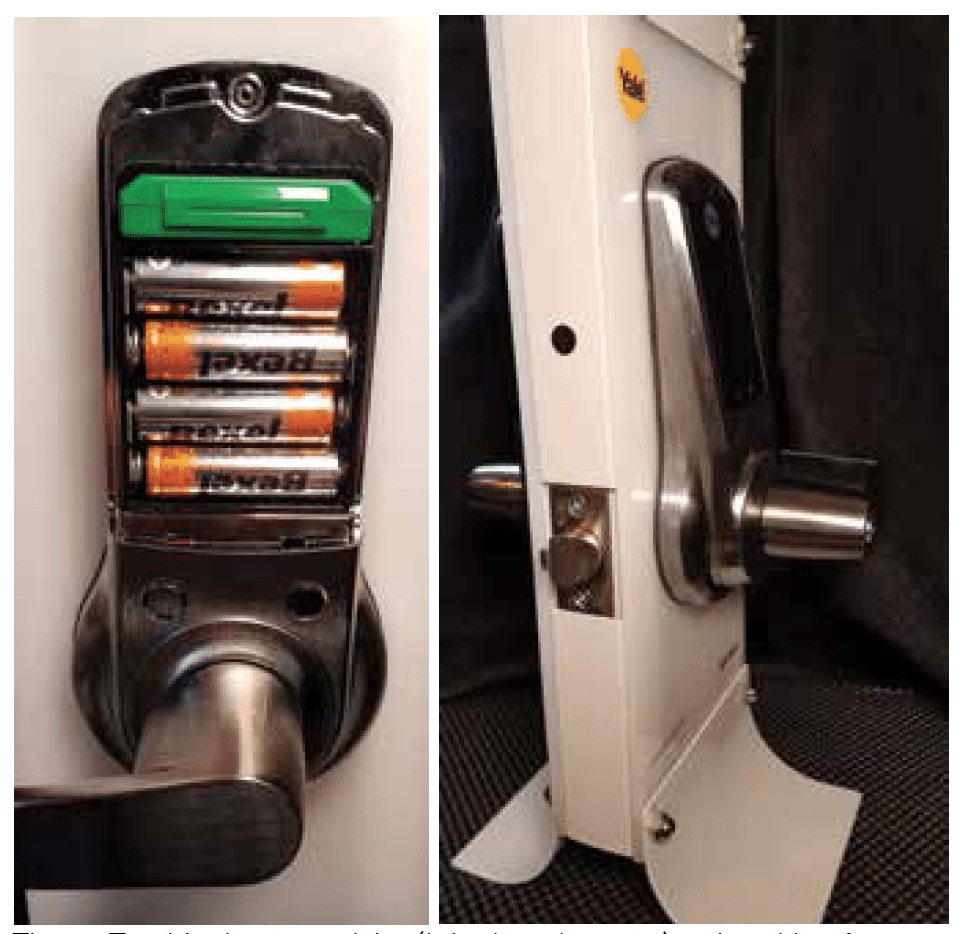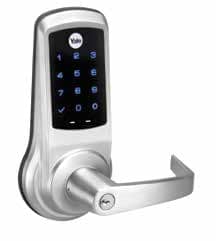WE HAVE TESTED AND REVIEWED keypad access locks in the past, including models from Schlage and Kwikset, most recently the Kwikset SmartCode 916 Touchscreen Deadbolt (securitysales.com/ kwikset_deadbolt_locks_reliable), and are big fans. After looking at promotional material for the Yale nexTouch keypad access lock, we asked for a test model but were really expecting a product that was functionally similar to the Kwikset 916. Well, they both have touchscreens (and are available with pushbutton keypads as well) and unlock doors, but they are otherwise pretty different. The question of which would work best for you really depends on your application.
The nexTouch lock is available in three versions: standalone, Data-on-Card and Z-Wave/ ZigBee. The standalone version is the base model, and while any version can be ordered from Yale, Data-on-Card, Zig- Bee or Z-Wave functionality can be added by installing a color-coded plug-in module. This allows the lock to be upgraded as the user’s application and needs change. We tested the Z-Wave version and cannot comment on the Data-on-Card version for this review as we did not test it.
Construction
The nexTouch is a solidly built, as befits its ANSI/BHMA Grade 1 certification. This grading system, developed for the American Nation Standards Institute (ANSI) by the Builder’s Hardware Manufacturers Association (BHMA) ranges from 1 (the highest grade) to 3, factoring in longevity and durability. Grade 1 is usually used for commercial applications and is tested to 1 million opening and closing cycles. It is also able to withstand five strikes of 75 pounds of force. Clearly solidly built, the nexTouch is intended for commercial applications, and it shows.
There are a number of configurations available, including the aforementioned choice of touchscreen or pushbutton as well as the underlying technology. There are three different lever designs, including a flat lever and two types of curved levers. A lock cylinder override is available, and a number of Yale interchangeable cores can be used. There are also four finishes available, including bright brass, satin bronze, satin chrome-plated (our test model) and flat black powder coat. There are even kits to adapt other manufacturers’ cores to fit this lock; it is hard to imagine more flexibility in construction. We did not install the lock on a door, as it came on a “mock door” for testing purposes. Interestingly, it was installed in the test rig with the latchbolt backwards; perhaps this was a test to see if we’d notice. We did take the unit apart and put it back together again, and the operation was constant with our experiences installing other brand locks.
Features
The nexTouch is really an access control system for smaller facilities, and is designed for a large number of users and a “jack of all trades” maintenance person. Think apartment building or multifamily residences, small businesses or small office buildings. The standalone unit handles 500 user codes and each code can be four-eight digits. There are a number of features that support these applications, and we tested as many of them as we could.
The first feature that really jumps out is the voice guidance. It walks you through all of the programming in your choice of three languages, confirms operations and allows a maintenance person or administrator to easily change settings without referring to the manual (which is really just a poster). A pleasant chime confirms operations, letting you know when the door is locked and unlocked. Certain modes are annunciated, like “Privacy Mode,” which allows you to lock out the keypad from the inside. To do this you need to install the optional door position switch and associated magnet, which allows the lock to know when the door is closed. Opening the door automatically disables the privacy mode.
You can also set the lock to unlock at the first valid keypad entry and relock either manually or after a preset period (configurable from 1-180 seconds). Relocking manually can require a valid PIN code or one-touch locking can be enabled that allows a simple touch of the keypad to relock the door. There’s also a keypad lockout feature that deters tampering by disabling the keypad for a default period of 180 seconds after five successive wrong code entries.
Powering the lock is also carefully thought out. The unit is battery powered with the four included AA batteries, or can be outfitted with a remote power source through an electronic pass-through hinge. If the internal batteries are used and they fail, two contacts on the front of the lock allow you to press a 9V battery up to the lock that will provide enough power to enter an access code and open the door to change the batteries. A belt and suspenders, indeed!
Setup
As with other locks we have seen, the installation and operation manual is a poster and it has everything you need. Once installed, inserting the batteries provides you with a voice prompt (“Welcome to Yale”) and touching the screen prompts you through entering the master PIN code and subsequent user codes. Visual and audible prompts confirm almost all actions, and the programming is very simple.

Testing
We went through the poster and tested each feature with no issues. We liked the door position switch and privacy mode and wish other locks had that feature. The keypad is extremely sensitive and responsive, shows up well in direct sunlight, and the audible confirmation was a nice touch. There are two volume settings for audio, and it can be disabled as well if you find it annoying over time.
We also tested Z-Wave functionality using a SmartThings hub. We had to try a few times; that isn’t uncommon with Z-Wave devices and the nature of home automation networks. Once set up, the lock worked flawlessly, locking and unlocking with about 3 seconds’ latency. We have other Z-Wave locks in our test setup, and the speed in which the Yale lock responded was consistent with our experiences. We did notice that the SmartThings application showed the lock as locked about 5 seconds before it had relocked itself, so there may be some software or integration issues. This did not impact operation, and reporting on home automation applications is not universally instantaneous. We did not test the ZigBee version, although we can’t imagine that it would be different than the Z-Wave functionality and performance.
Conclusions
If you are looking for an attractive lock for home use, this may not be it. It is definitely a commercial design and may be out of place in residential applications. That being said, for the intended applications, it is hard to imagine a better implementation and feature set. We gave a perfect rating to the similar Kwikset product, and we give the Yale lock the same high marks.
That is not to say the products are the same; each has different strengths and we did not take off points because of differentiating features. However, we think it is safe to say that, no matter what the application, there’s a perfect fit for you.
Verdict
- Features 1 2 3 4 5
- Construction 1 2 3 4 5
- Setup 1 2 3 4 5
- Performance 1 2 3 4 5
- Overall 1 2 3 4 5
First published in the March 2017 Security Sales & Integration magazine.




